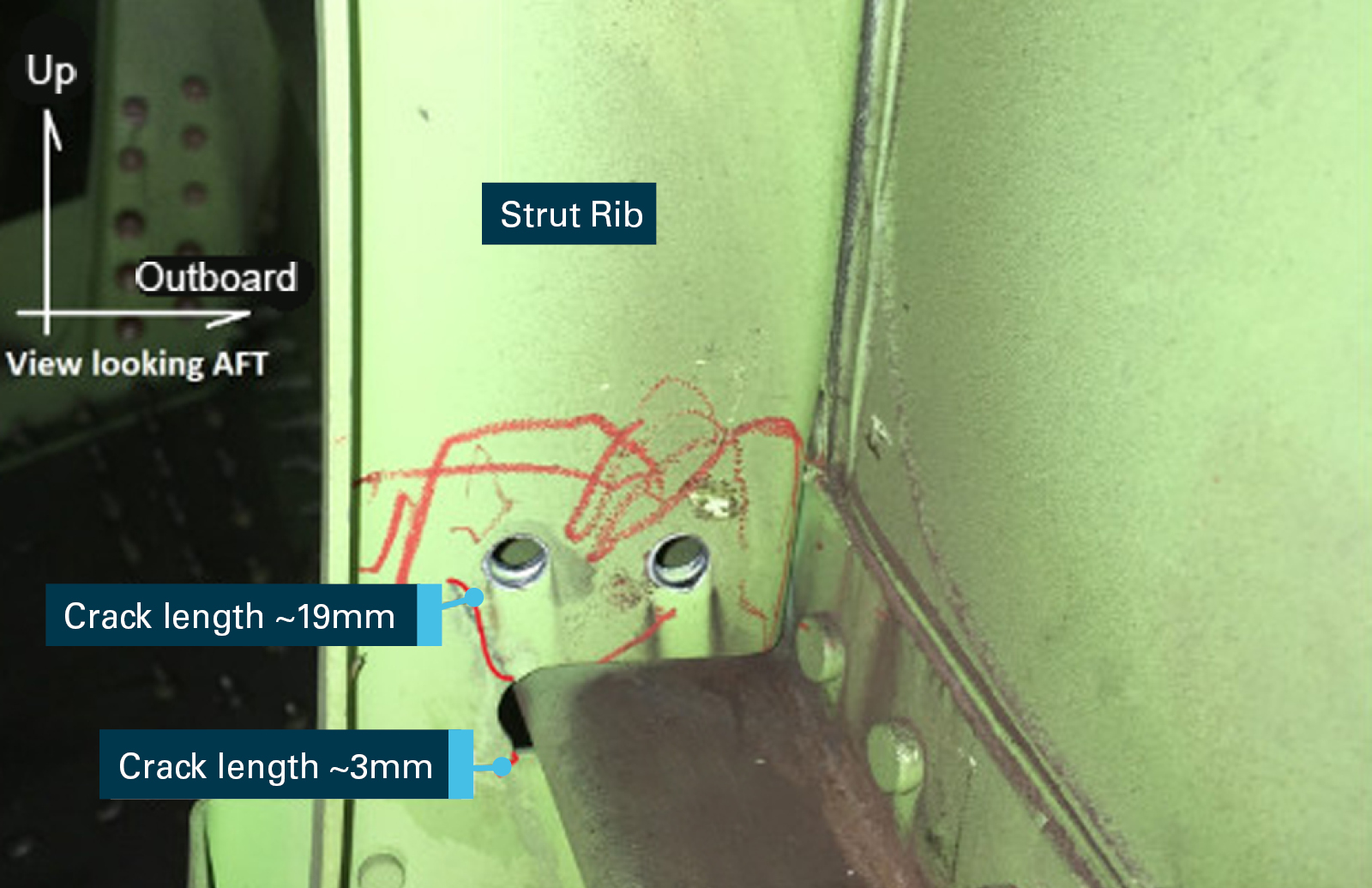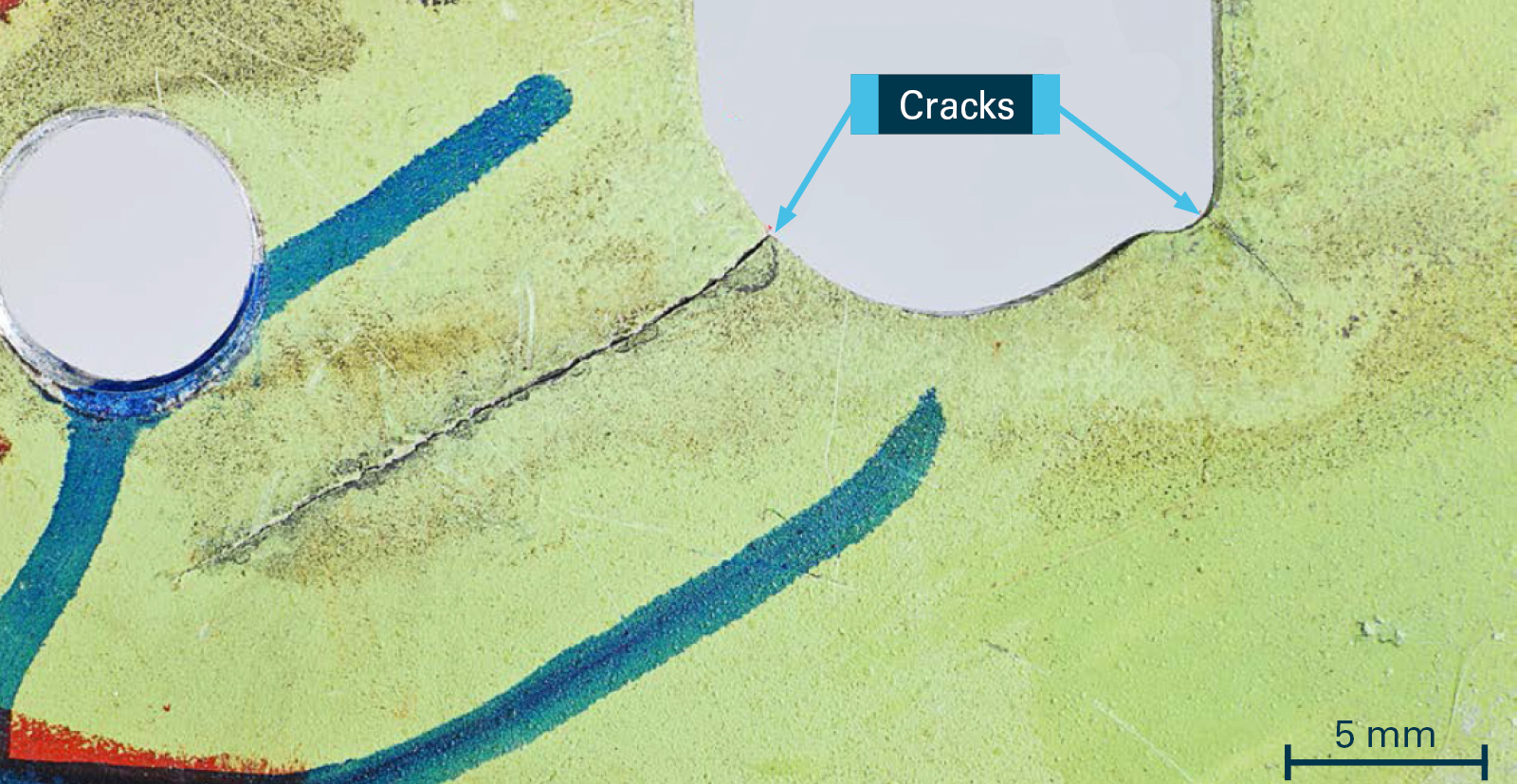What happened
On 5 October 2016, a Qantas-operated Boeing 747-438 aircraft, registered VH-OJT (Figure 1) was undergoing routine maintenance at a contracted repair and overhaul facility in the Hong Kong Special Administrative Region (SAR) in the People’s Republic of China. Inspection of the No. 2[1] engine pylon identified cracking of four outboard strut ribs from within the torque box of the pylon (Figure 2).
Following technical advice from Boeing, the No. 2 engine was removed from its wing installation to allow access to the pylon and removal of the cracked strut ribs. The aircraft was repaired and, after completing the maintenance visit, it was returned to regular passenger service. The cracked ribs were sent to Boeing’s facilities in the United States for specialist metallurgical examination.
Figure 1: Qantas Boeing 747-438 aircraft, registered VH-OJT

Source: Christopher Chai
Pylon inspection requirements
The engines on a Boeing 747 aircraft are mounted to pylons located on the underside of each wing. The pylons transmit thrust from the engine to the airframe and are designed to withstand flight loads from normal operation along with transient dynamic loading in the event of an engine failure. Hydraulic, fuel, electrical and air conditioning lines all pass through the pylon structure.
Boeing’s ongoing maintenance requirements included an inspection of the engine pylon every 48 months. A general visual inspection within the torque box for corrosion damage was required along with a more detailed inspection for cracking of the ribs. The procedures noted that during the inspection, particular attention should be applied to the cutaway where stringers passed through each rib.
Qantas reported to the ATSB that several years prior to this occurrence, it had independently increased the frequency of the zonal inspections from 48 to 24 months due to repeated instances of corrosion and cracking damage within the pylon region. That new inspection interval was formalised by Qantas within its maintenance documentation for its 747 fleet.[2]
Figure 2: Boeing 747 engine pylon showing the location of the cracking (highlighted)

Source: Boeing, annotated by the ATSB
Manufacturer’s examination
Following removal from the aircraft, four cracked outboard strut ribs were sent to Boeing for metallurgical examination and fracture analysis. The examination confirmed that five cracks had developed in the strut ribs, all emanating from the rib cutaway region, ranging in length from 3—19 mm (Figure 3 to Figure 5). Boeing’s report[3] contained the following detail:
- Optical examination of the fracture surfaces was conducted and no anomalies were found that might otherwise have contributed to the development of the cracking.
- Scanning electron microscopy (SEM) of the fracture surfaces did not find any aberrations or defects on the surfaces of the strut ribs that might have otherwise contributed to the development of the cracking.
- SEM analysis of the fracture surfaces confirmed that each strut rib had striations and crack-progression marks consistent with fatigue cracking. No evidence was found of ductile tearing or plastic deformation at the crack origins, which might otherwise suggest that the fatigue cracking had initiated due to excessive vibration or torque loads from a transient engine event.
- Metallographic examination of the aluminium alloy microstructure from each rib did not reveal any abnormalities that could have led to the fracture of the strut ribs.
- Chemical analysis of each strut rib found the composition met the materials specifications, as listed within the engineering drawings.
- Hardness and conductivity measurements from each strut rib confirmed that they were within the correct range, as listed within the engineering drawings.
- The ribs were painted and primed in accordance with manufacturing specifications.
Boeing also conducted a structural loads analysis on the pylon, which confirmed that despite the presence of the cracking, the No. 2 engine pylon retained sufficient residual strength for all certified loading conditions.
Figure 3: A strut rib in-situ within the No. 2 pylon with two cracks identified

Source: Boeing, annotated by the ATSB
Figure 4: The strut rib from Figure 3 after removal from the pylon

Source: Boeing, annotated by the ATSB
Figure 5: Close-up of the cracking in the cutaway region shown at Figure 4

Source: Boeing, annotated by the ATSB
Aircraft history
On 24 June 2016, a few months before the detection of the pylon cracks, VH-OJT sustained a failure of the low-pressure turbine from the No. 2 engine during the take-off roll. This resulted in a high-speed seizure of the engine resulting in significant vibration and torque loads on the pylon. Following removal of that engine, the pylon was inspected and no damage to the critical structural members was evident.
Maintenance records noted that when the cracks were discovered in the Hong Kong SAR, the aircraft had accumulated 79,928 hours and 8,313 landings. There were no other identified defects reported from previous inspections on the No. 2 strut support assembly for VH-OJT.
Safety analysis
Cracking of the engine pylon strut ribs
During routine maintenance on 5 October 2016, four strut ribs from the No. 2 engine pylon were found to have developed fatigue cracks. The parts met the manufacturer’s engineering drawing and material specifications. With no obvious defects detected, it is likely that the fatigue cracking developed from exposure to vibratory loading that occurred within the pylon during normal engine operation. A factor that may have contributed to the crack growth was the number of hours and flight cycles that the airframe had accumulated within its service life. The manufacturer’s analysis indicated that despite the crack damage to the ribs, the pylon retained sufficient residual strength for all load cases, which indicates that the aircraft remained safe to operate.
Approximately 6 months prior to the detection of the strut rib cracking, the No. 2 engine sustained a seizure that resulted in the transmission of significant vibratory and torque loads into the pylon structure. Metallurgical analysis of the fracture at the crack origins did not show any evidence of plastic deformation or tearing of the alloy that might otherwise suggest that the seizure was a contributing factor to the cracking.
Pylon inspection
When compared with the 48-month inspection interval recommended by the manufacturer, the 24‑month inspection interval set by Qantas provided greater opportunity for the timely detection of cracking and other defects within the pylon. The reduced inspection interval proved effective in this case, detecting cracks before they reached a level considered by the manufacturer to be a safety risk.
Findings
These findings should not be read as apportioning blame or liability to any particular organisation or individual.
- The fatigue cracking in four outboard strut ribs in the No. 2 engine pylon is likely to have developed from exposure to vibratory loading within the pylon during normal engine operation over the aircraft’s service life.
- The extent of fatigue cracking in the ribs did not affect the structural integrity of the pylon for all certified load cases, which meant that the aircraft’s safe operation was not affected.
Safety message
The Qantas Boeing 747 maintenance program for the engine pylon area is completed at a higher frequency and in more detail than is required by Boeing. This enhanced inspection regime was effective in detecting cracking of the strut rib assembly, before the cracks reached a level considered to be a safety risk.
This occurrence highlights the importance for vigilance during ongoing routine maintenance activities. It also highlights that, when relevant, operators should consider reviewing prescribed maintenance schedules in order to address issues that may develop as their aircraft age and accumulate time in service.
Purpose of safety investigationsThe objective of a safety investigation is to enhance transport safety. This is done through:
It is not a function of the ATSB to apportion blame or provide a means for determining liability. At the same time, an investigation report must include factual material of sufficient weight to support the analysis and findings. At all times the ATSB endeavours to balance the use of material that could imply adverse comment with the need to properly explain what happened, and why, in a fair and unbiased manner. The ATSB does not investigate for the purpose of taking administrative, regulatory or criminal action. TerminologyAn explanation of terminology used in ATSB investigation reports is available here. This includes terms such as occurrence, contributing factor, other factor that increased risk, and safety issue. Publishing informationReleased in accordance with section 25 of the Transport Safety Investigation Act 2003 Published by: Australian Transport Safety Bureau © Commonwealth of Australia 2018
Ownership of intellectual property rights in this publication Unless otherwise noted, copyright (and any other intellectual property rights, if any) in this report publication is owned by the Commonwealth of Australia. Creative Commons licence With the exception of the Coat of Arms, ATSB logo, and photos and graphics in which a third party holds copyright, this publication is licensed under a Creative Commons Attribution 3.0 Australia licence. Creative Commons Attribution 3.0 Australia Licence is a standard form licence agreement that allows you to copy, distribute, transmit and adapt this publication provided that you attribute the work. The ATSB’s preference is that you attribute this publication (and any material sourced from it) using the following wording: Source: Australian Transport Safety Bureau Copyright in material obtained from other agencies, private individuals or organisations, belongs to those agencies, individuals or organisations. Where you wish to use their material, you will need to contact them directly. |
__________
- The Boeing 747 has four engines numbered one through to four. The No. 1 engine is located at the outboard position on the left wing and the No. 4 engine is located at the outboard position on the right wing. Engines No. 2 and No. 3 are at the respective left and right inboard wing positions.
- Qantas Engineering and Maintenance procedure, J-744-C2-54-010 (Zonal inspection of No.2 engine strut).
- Boeing Research and Technology Lab Report SR 15601, dated 20 May 2017.


